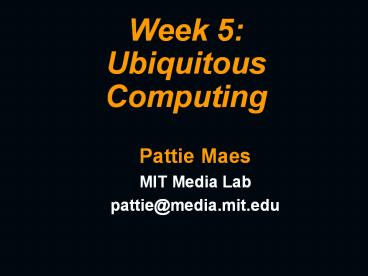Week 5: Ubiquitous Computing - PowerPoint PPT Presentation
Title:
Week 5: Ubiquitous Computing
Description:
Perspectives article for ACM Interactions, Weiser 1993 ... board, white board, flip chart, electronic bookcase (download things onto a PAD) ... – PowerPoint PPT presentation
Number of Views:106
Avg rating:3.0/5.0
Title: Week 5: Ubiquitous Computing
1
Week 5 Ubiquitous Computing
- Pattie Maes
- MIT Media Lab
- pattie_at_media.mit.edu
2
Ubiquitous Computing
- Required reading
- Ubiquitous Computing, Weiser, 1993
- Perspectives article for ACM Interactions, Weiser
1993 - The coming age of calm technology, Weiser Seely
Brown, 1996
3
Ubiquitous Computing
- Optional ReadingsSome computer science issues
in ubiquitous computing, Weiser 1993 Sajid Sadi
http//www.ubiq.com/hypertext/weiser/UbiCACM.html - Charting Past, Present, and Future Research in
Ubiquitous ComputingGD Abowd, ED Mynatt, 2000
Sajid SadiSelection from UbiComp
Proceedings/Videos last couple of years Aaron
Zinman
4
March 2nd (cont)
- PROJECT PROPOSAL DUE!!!
- 2-3 pages
- What is it why is it interesting?
- Usage Scenario
- How will it be implemented?
- What parts will you complete for this class
- What do you hope to learn?
5
Mark Weisers vision (1988-on)
- Disappearing technologies are most profound
ones - Eg writing ubiquitous, does not require active
attention, ready for use at a glance - The best tools are invisible tools (focus is on
the task not the tool)
6
Information Technology is not (yet) a
disappearing technology
- Computer remains in world of its own, not
integrated in environment - Approachable only through complex jargon that has
nothing to do with tasks being used for - Not just UI issue, also a hardware issue
7
What does it mean for a technology to disappear?
- Not consequence of technology
- But of human psychology
- When people learn something sufficiently well,
they cease to be aware of it, they can focus
beyond the technology on new (true) goals - Called compiling by H. Simon, or periphery by
J. Seely Brown
8
Weisers vision Ubiquitous Computing
- Computers everywhere, disappearing/integrated in
environment/objects around us - Computer no longer isolates us from
tasks/environment, no longer focus of attention - Social ImpactSimilar to writing found
everywhere from clothes labels to billboards - Similar to electricitywhich surges invisibly
through the walls of every home, office, car
9
Ubiquitous computing constitutes a reversal of
some other trends
- Ubiquitous computing does not mean
- Computers that can be carried everywhere
- Multi-media computers (using more sensors/output
modalities) - Virtual reality (create a world inside the
computer, rather than enhance the real world with
computer data) - Computer as personal assistant, agent
10
Ubiquitous Computing
- Hundreds of computersin every room
- Wirelessly networked
- With their own display
- Computation happens in the background
11
Xerox Parc Experiments in Ubiquitous Computing
- Focus on devices that transmit display
information - Two important issues
- Location (UCs must know where they are so they
can adapt their behavior) - Scale (different scales needed to suit different
tasks) tabs (post-it), pads (paper) and boards - Typical room hundred tabs, 10-20 pads, 1-2
boards, all inter-connected
12
Some TAB examples
- Active badges for people or objects
- Automated call forwarding based on location of
people - Automatic login to computers
- Automatic diaries (eg meeting)
- Tabs as extensions of computer screens (to make
programs/file portable to other machine)
13
Some PAD examples
- Differ from conventional portable computers
intended as scrap computers no individualized
identity or importance spread many around the
desk, in drawers, etc - Increase desk size of current computers
14
Some BOARD examples
- Number of purposes video screen, bulletin board,
white board, flip chart, electronic bookcase
(download things onto a PAD) - Liveboard works with wireless, electronic
chalk, is interactive - permits collaboration at a distance
- Also used as personalized bulletin boards (user
wears active badge)
15
Cons of Ubiquitous Computing
- The current computer is
- Generic
- Adaptive
- Programmable (extensible)
- Space
- Cost
16
State of Ubiquitous Computing
- Conferences
- Ubicomp
- Mobiquitous
- Pervasive Computing
- Journals
- IEEE Pervasive Computing journal
- Springer Personal Ubiquitous computing journal
17
Calm Technology, Weiser Seely Brown
- Ubicomp community went off track
- Ubicomp technology should be calm stay out of
the way while informing - Contrast with the way technology is designed
nowin your face, highly interactive,using
multiple modalities, etc
18
Calm Technology, Weiser Seely Brown
- Calm technology enhances our peripheral reach
(bringing more details into the periphery) - Periphery What we are attuned to without
attending to explicitly, Informing without
overburdening, - Calm technologies move easily between center of
attention periphery (eg text)
19
CalmTechnology
- Other word for Ambient Interfaces (Ishii)
- Example
- dangling string representing network traffic
(Jeremijenko) - Inner office windows
- Internet muticast (window of awareness)
20
March 9 User Modeling, Personalization
Recommender Systems
- Required reading
- Alfred Kobsa, Generic User Modeling Systems, User
Modeling and User-Adapted Interaction, v.11
n.1-2, p.49-63, 2001
21
March 9 User Modeling,Personalization
Recommender Systems
- Optional resources on recommender systems
- Recommender Systems, Resnick Varian
http//www.acm.org/pubs/cacm/MAR97/resnick.html - Recommender systems in ecommerce, Shafer et al
http//www.cs.umn.edu/Research/GroupLens/papers/pd
f/ec-99.pdf - Empirical Analysis of Predictive Algorithms for
Collaborative Filtering, Breese, Heckerman and
Kadie http//www.research.microsoft.com/users/bree
se/cfalgs.html
22
March 9 User Modeling,Personalization
Recommender Systems
- Optional resources on user modeling
personalization - User Modeling in Adaptive Interfaces, Langley
http//www.cs.utah.edu/classes/cs5350/handouts/ada
pt.um99.pdf - User Modeling in Human-Computer Interaction,
Fischer, http//l3d.cs.colorado.edu/gerhard/paper
s/umuai2000.pdf
23
(No Transcript)































